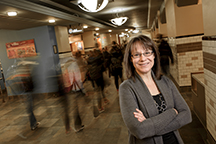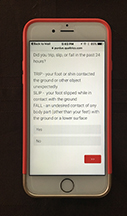March 9, 2016
Don’t let youth trip you; more than 50 percent young adults fall, trip
 |
|
Shirley Rietdyk, a professor of health and kinesiology, found that young adults fall more frequently than expected and most falls occur during everyday activities such walking and talking. These research findings are published in Human Movement Science. (Purdue University photo/Charles Jischke) |
WEST LAFAYETTE, Ind. — Young adults fall more frequently than expected, and most falls occur during everyday activities such walking and talking, according to new research from Purdue University.
“The most commonly cited statistic is that one in three older adults falls each year due to age-related changes in balance, and in this four-month study, more than half of the college students fell during daily activities,” said Shirley Rietdyk, a professor of health and kinesiology, who only looked at young adults in this study. “The fall rate may be lower for older adults because they are more cautious due to the higher risk of serious, even fatal, injuries from falls. These findings also highlight that walking on two legs is a challenging task that is mechanically unstable, even for young, healthy adults.”
The findings are published in Human Movement Science and are based on data collected from 94 undergraduate college students via a daily online survey about any slips, trips or falls in the past 24 hours. The students’ average age was 19, and the response rate was 93 percent.
 |
|
The findings are based on data collected from 94 undergraduate college students via a daily online survey about any slips, trips or falls in the past 24 hours. Shirley Rietdyk, a professor of health and kinesiology, found each student averaged one slip or trip a week, but they recovered their balance for most of these perturbations. Also, 52 percent of the participants fell at least once during the four months, and 21 percent fell more than once. (Image provided) |
Each student averaged one slip or trip a week, but they recovered their balance for most of these perturbations. Fifty-two percent of the participants fell at least once during the four months, and 21 percent fell more than once. Sixteen percent of the falls resulted in injury, and 4 percent required medical treatment. Also, one-third of the falls happened indoors, and the fall rate was still high when winter weather conditions were excluded. While physical activity did not distinguish fallers from those who didn’t fall, falls were more frequent as the physical activity level increased.
The study also examined other factors related to falls, such as substance abuse, which was attributed to 9 percent of the falls.
“The most common multi-task associated with falling was talking to someone while walking,” Rietdyk said. “Despite recent research showing an increase in injuries due to texting while walking, only 3 percent of falls resulted from texting while walking in this study. This is likely due to the fact that people texting are more likely to be injured from walking into or in front of things, which may not result in a fall.”
According to the Centers for Disease Control and Prevention, falls are the third leading cause of unintentional injuries for ages 18-35, but how often young people fall has not been well documented.
“We have all heard the expression, ‘He can’t chew gum and walk at the same time,’” Rietdyk said. “Similarly, we expect that talking while walking would be automatic. However, this multi-task is cognitively demanding, requiring the simultaneously management of language formulation, speech generation, terrain navigation, and balance control.”
Rietdyk’s research is funded by Purdue’s Department of Health and Kinesiology. She also is a faculty associate with Purdue's Center on Aging and the Life Course. The paper was co-authored by Michel Johannes Hubertus Heijnen, a graduate student in health and kinesiology. Heijen also received two fellowships to support his work on this project, the Bilsland Dissertation Fellowship and the Purdue Research Foundation Research Assistantship.
Rietdyk and Babak Ziaie, a professor in the Purdue School of Electrical and Computer Engineering and Weldon School of Biomedical Engineering, co-founded SmartGait LLC, which is commercializing a tool to help health-care officials assess a person's risk of falling and identifying ways to avoid injury. Rietdyk collaborates with Jessica Huber, a professor in the Department of Speech, Language and Hearing Sciences; and Jeffrey Haddad and Meghan McDonough, both associate professors in the Department of Health and Kinesiology, to determine the effects of balance training on walking while talking in people with Parkinson’s disease and older adults.
Writer: Amy Patterson Neubert, 765-494-9723, apatterson@purdue.edu
Source: Shirley Rietdyk, 765-496-6703, srietdyk@purdue.edu
Note to Journalists: Journalists interested in a copy of the Human Movement Science article, "Falls in young adults: Perceived causes and environmental factors assessed with a daily online survey," can contact Amy Patterson Neubert, Purdue News Service, at 765-494-9723, apatterson@purdue.edu
Falls are the third leading cause of unintentional injuries for ages 18-35 years (CDC), but the causes and circumstances of falls in this age group are understudied. The purpose of this study was to document the frequency and circumstances of falls in young adults with a daily online survey. Ninety-four undergraduate students (19 ± 0.9 years) received a daily email for 16 weeks regarding slips, trips and falls in the past 24 h (93% response rate). More than half of the participants (52 %) feel in the 16-week interval. Injuries were reported in 16% of falls, and medical treatment was received in 4% of the falls. The majority of falls occurred while walking (58%), and the main cause of the fall was a slip (48%) or trip (25%). On average, participants fell once out of every 18 perceived slips and trips. Physical activity level did not distinguish fallers from non-fallers (p = 0.45), but for those who did fall, falls were more frequent as physical activity level increased (p = 0.007). The high fall and injury rate in a short interval reflects the inhere instability of bipedal locomotion and indicates that falls are not a trivial problem for young adults.

